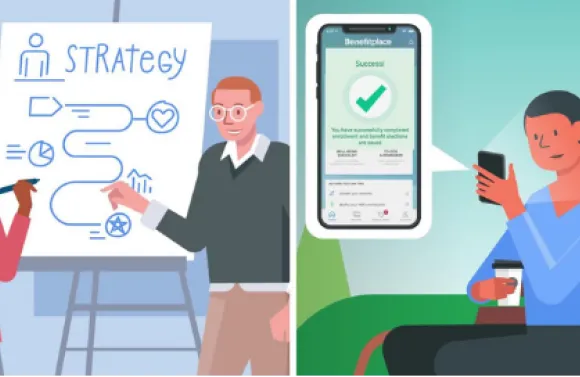
As a benefits professional, you're responsible for supporting your organization’s overall talent management strategy. This is an important responsibility that helps you plan your objectives and deliver results. But it's your unwavering passion to make employees’ lives better – it ignites your drive and keeps you fulfilled. Delivering the best benefits experience — during annual open enrollment and beyond — is a crucial component to your success and also your sense of accomplishment.
As your company has grown, your needs as a benefits professional and organization have evolved. That’s why you might have moved away from legacy, back-office “systems of record” — static modules that manage transactions and run the HR side of the business – and moved towards a “system of engagement” — dynamic HR software to support open lines of communication, employee engagement and meaningful interactions that have a direct impact on your workforce. Or at least it held the promise to do that. But here you are in a post-pandemic world, with five generations converging in the workforce, wondering if you made the right decision. Or maybe it's even worse...maybe you haven't made a change at all in the last five years. (gasp!)
The needs of yesterday are not the same as the needs of today (or your needs of the future for that matter), and this is the same for your workforce.
Has your benefits administration system kept up? Let’s take a look at some common symptoms that could mean you're facing a big problem – you’ve outgrown your current benefits technology.
Symptom 1: You get asked the same simple benefit questions repeatedly.
The Real Problem: If you're experiencing this, it could be a sign that your system has not kept up with the modern benefits consumer and their expectations of easy-to-use technology paired with the benefits education to make better decisions. Employees want easy ways to access the benefits information they need at the time they need it. Keeping your employees informed and engaged beyond open enrollment is important now more than ever. Consider that more than a third of American workers don't understand the benefits they elected during open enrollment.1 Employees need help understanding their plan options to determine which one is the right fit for them and need guidance throughout the rest of the year when it’s actually time to use their plan.
The Result: Technology is supposed to help simplify benefits enrollment and empower your employees. However, if employees don’t know where to go to get that information (or if they do know, but it’s too difficult to find the information quickly), then they continue to feel confused and overwhelmed. Additionally, the value of your time is diminished, as you now have to spend time answering the same common questions versus focusing on your benefits strategy and vision for your workforce.
If this is a symptom you can relate to, here are some questions to consider in determining if you’ve outgrown your benefits technology:
- Do employees have convenient access to all of their benefits information whether they're using a desktop or smartphone?
- Is the enrollment workflow designed so that employees aren't overwhelmed by the options presented to them?
- Do you have the options to customize benefit information as you observe patterns or trends of areas that cause confusion for employees?
- Is there search functionality? Can employees type in a keyword and see questions and answers defined by their benefit team at their fingertips?
- Are there multimedia tools like video or chat that make getting benefits information in the hands of your employees easier?
Symptom 2: You don't have time to evaluate, let alone implement and administer new benefits.
The Real Problem: Your benefits strategy should drive your technology, not the other way around. So, if you aren’t able to easily expand your benefit offerings and deliver a seamless enrollment experience, it’s a sign that your platform doesn't provide the flexibility or data exchange capabilities you need to efficiently manage a strategic benefits program.
The Result: Without established data exchange connections or APIs that make it easy to seamlessly integrate new benefits, you're saddled with the burden of figuring out how to create the connections yourself. That means you're either sending employees to third-party sites to enroll in certain benefits or having to manually enroll them yourself. Or worse, you deal with what you have and risk losing employees to competitors who are able to offer a more attractive benefits package.
Do you experience this symptom? Here are questions to pose in determining if your benefits technology hasn’t kept pace:
- Does your technology provider offer insight into what benefit programs might fit the unique needs of your employee population?
- Are you able to support various business rules that would allow part-time employees to enroll in voluntary benefits?
- Are you able to expand your benefits mix with minimal dependencies on your IT team?
- Do you have access to dashboards that provide insight into file delivery schedules and/or file acceptance by your carriers?
- Does your technology support the management of complex Evidence of Insurability (EOI) rules systematically?
Symptom 3: You haven't received any enhancements to your current system in ages, or you feel out of the loop on the latest features.
The Real Problem: Your technology providers treats you more as a transaction than a true collaborative partner in technology design. If your benefits solution is more of an "add-on" to your HCM system, then it's likely it doesn't get the investment it needs to keep up with evolving needs. Other providers may do the bare minimum based on regulatory changes rather than listening to feedback from their customers.
The Result: Change is the only constant in the benefits industry, and technology providers that don't listen to how customers' needs evolve are going to fall short of meeting, much less exceeding expectations. Customer service becomes a number you dial when you have an issue, rather than a strategic partner you can count on to support you with insight, expertise and best practices to simplify growing complexity drive your benefits strategy forward.
Feel similar to what you're experiencing? These questions may help you identify whether you have a benefits technology you can trust:
- Do you have an opportunity to influence your technology provider's roadmap?
- How often are new features and functionality rolled out?
- Do you have a dedicated customer support team that you know by name?
- Is the process to resolve an issue managed in a timely manner?
In today’s world, life is complex. Benefits should be made easy all year long (for both you and your employees) with a benefits administration platform that lets you address today’s needs and tomorrow’s challenges. If that’s not what you are getting now, it may be time to re-evaluate your solution and consider a better way. Lucky for you, there is a complete guide to help you figure out what you're missing and find a partner that's just as passionate as you are about helping people make better decisions and lead better lives. Download your Benefits Administration Buyers Guide.



